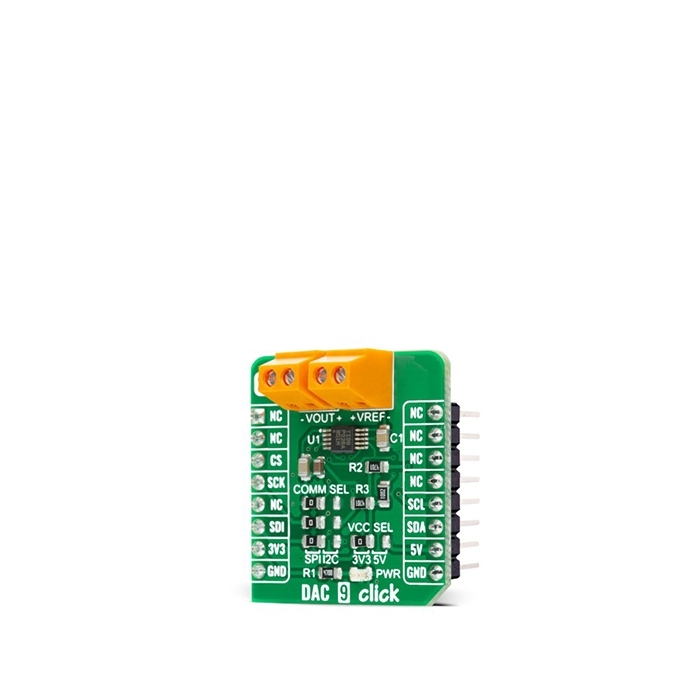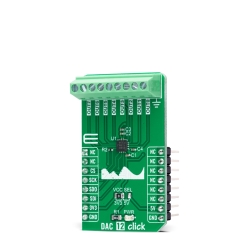MIKROE DAC 9 Click
DAC 9 Click is a compact add-on board that contains a fully-featured, highly accurate digital-to-analog converter.
Product Overview
DAC 9 Click is a compact add-on board that contains a fully-featured, highly accurate digital-to-analog converter. This board features the DAC80501, a 16-bit voltage-output digital-to-analog converter with precision internal reference from Texas Instruments. It supports both I2C and SPI serial interface and offers a linearity of < 1 LSB. It also includes a 2.5V internal reference, giving full-scale output voltage ranges of 1.25V, 2.5V, or 5V, incorporate a Power-On Reset function, consume a low current of 1mA, and include a Power-Down feature that reduces current consumption to typically 15μA at 5V. This Click board™ is suitable for applications such as offset and gain control, VCO tuning, programmable reference, and more.
DAC 9 Click is supported by a mikroSDK compliant library, which includes functions that simplify software development.
DAC 9 Click is based on the DAC80501, a single-channel, buffered, 16-bit resolution digital-to-analog converter from Texas Instruments. It includes a 2.5V, 5ppm/˚C internal reference, giving full-scale output voltage ranges of 1.25V, 2.5V, or 5V, and incorporates a Power-On Reset function. This function makes sure that the DAC80501 output powers up at zero scale or midscale and remains at that scale until a valid code is written to the device. High resolution and simple interface features make this Click board™ suitable for applications such as battery testers, communications equipment, factory automation and control, test and measurement, and more.
The output channel of the DAC80501, routed to the VOUT terminal, consists of a rail-to-rail ladder architecture with an output buffer amplifier that generates rail-to-rail voltages giving a maximum output range of 0V to VDD. The full-scale output range of the DAC output is determined by the reference voltage on the VREFIO pin, the reference divider setting, and the gain configuration for that channel set by the corresponding BUFF-GAIN bit. When the DAC80501 uses an internal reference, this voltage is also externally available at the VREF terminal and can sources up to 5mA. Besides, the user can bring the external reference voltage on this terminal in the case of the DAC80501 external reference configuration.
DAC 9 Click provides the possibility of using both I2C and SPI interfaces. The selection can be performed by positioning SMD jumpers labeled as COMM SEL to an appropriate position. Note that all jumpers must be placed to the same side, or else the Click board™ may become unresponsive. In SPI mode, the DAC80501 uses a 3-Wire SPI serial interface that operates at clock rates of up to 50MHz, while in I2C mode the DAC80501 can operate in Standard Mode (100 kbps), Fast Mode (400 kbps), and Fast-Plus Mode (1.0 Mbps).
This Click board™ is designed to be operated with both 3.3V and 5V logic voltage levels that can be selected via VCC SEL jumper. This allows for both 3.3V and 5V capable MCUs to use both the I2C and SPI communication lines properly. However, the Click board™ comes equipped with a library that contains easy to use functions and an example code that can be used as a reference for further development.
Features & Specs
- Interface: I2C, SPI
- Compatibility: mikroBUS™
- Dimensions: 28.6 x 25.4mm
- Input Voltage: 3.3V or 5V
- Supply Voltage: Min. -0.3V, Max. 6V
- Maximum VREF Supply Voltage (EXT): Min. -0.3V, Max. VCC+0.3V
- Maximum VOUT Output Voltage: Min. -0.3V, Max. VCC+0.3V
- Resolution: 16 bits
- Operating Temperature Range: Min. -40°C, Max. +125°C
Documentation
Customer Reviews

Stock and Customer Discounts
Available Discounts
- $14.20 | 25+ units
- $13.46 | 100+ units
















